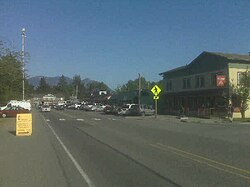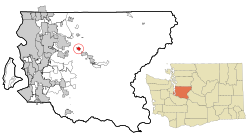Fall City
| Fall City, Washington | |
|---|---|
| CDP | |

Downtown Fall City, 1999
|
|
 Location of Fall City, Washington |
|
| Coordinates: 47°33′59″N 121°53′42″W / 47.56639°N 121.89500°W | |
| Country | United States |
| State | Washington |
| County | King |
| Government | |
| • Type | Unincorporated area |
| Area | |
| • Total | 1.3 sq mi (3.4 km2) |
| • Land | 1.3 sq mi (3.4 km2) |
| • Water | 0.0 sq mi (0.0 km2) |
| Elevation | 105 ft (32 m) |
| Population (2010) | |
| • Total | 1,993 |
| • Density | 1,253.5/sq mi (484.0/km2) |
| Time zone | Pacific (PST) (UTC-8) |
| • Summer (DST) | PDT (UTC-7) |
| ZIP code | 98024 |
| Area code(s) | 425 |
| FIPS code | 53-23200 |
| GNIS feature ID | 1531451 |
Fall City is an unincorporated area in King County, Washington, United States. Located 26 miles (42 km) east of Seattle, the community lies along the Snoqualmie River. The population was 1,993 at the 2010 census.
The first settlements in the area were two forts built in 1856 during the Puget Sound War to protect future settlers against possible uprisings by the native population. Fort Patterson, a few miles downstream, and Fort Tilton, a few miles upstream, were built with the help of Indians led by Chief Patkanim, and both abandoned within 2 years after interactions with the local tribes remained peaceful. A historical marker can be found north of Fall City on the Fish Hatchery Road where Fort Tilton once stood.
A trading post was established near the present day location of the Last Frontier Saloon in 1869 and became a hub of the local economy. Fall City was known at the time as "The Landing", as shallow water and rapids upstream on the Snoqualmie were impassable to the large dugout canoes used for transporting goods. In the early 1870s the first local mill in the Snoqualmie Valley was opened at the mouth of Tokul Creek, just downstream from Snoqualmie Falls and just upstream from where Fall City would be. The Fall City Post Office opened June 10, 1872.
The first small steamboats started ferrying supplies up the river in 1875. In the late 1880s, a group of Puget Sound businessmen founded and started building the Seattle, Lake Shore & Eastern railroad including a line up into the upper Snoqualmie Valley, in an attempt to build a line over the Cascade range. The land claim holder at the time, Jeremiah "Jerry" Borst, had Fall City surveyed and platted in anticipation of the people the railroad would bring, but was disappointed in 1889 when the railroad line was built a mile (1.6 km) away from the community.
...
Wikipedia
